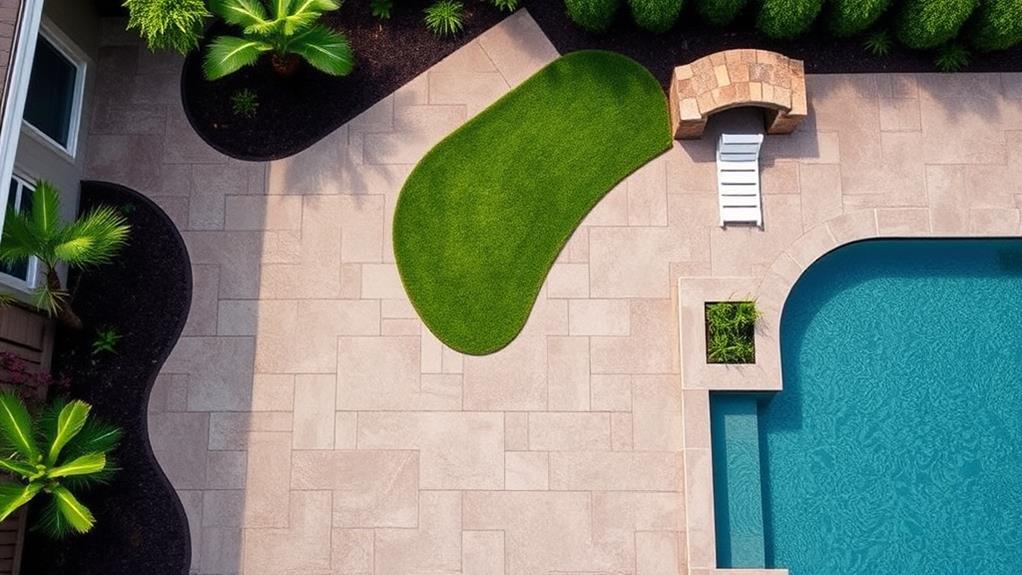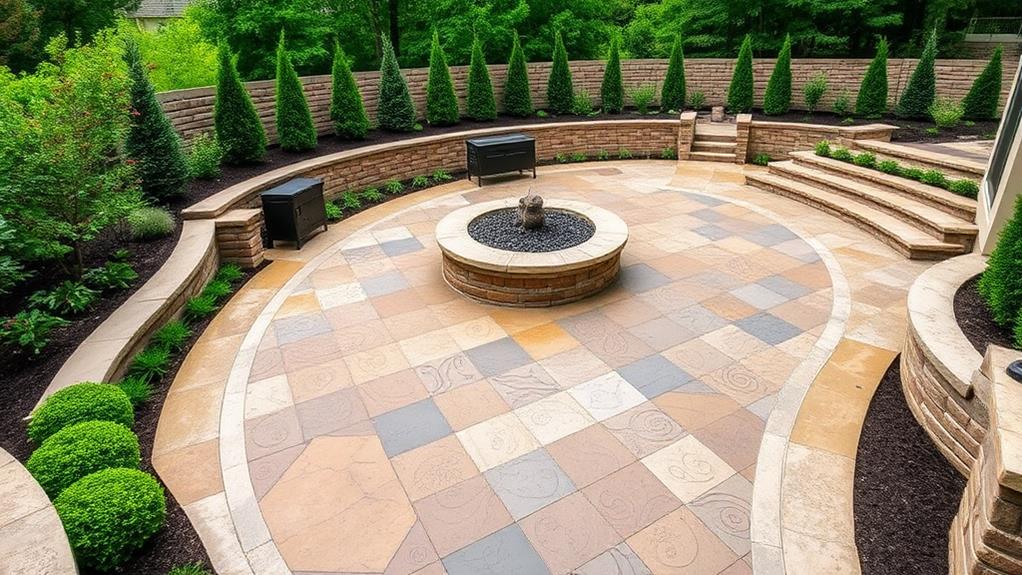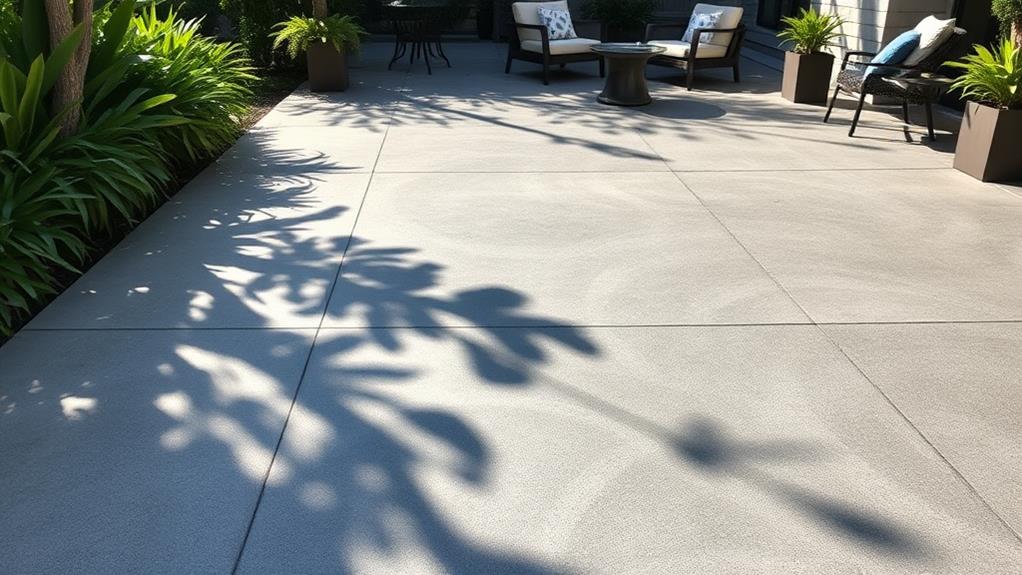Exploring the Versatility of Decorative Concrete in Landscape Design

You've likely seen decorative concrete in various outdoor settings, but you may not have realized its full potential for transforming your landscape. From elegant patios to striking driveways, this versatile material offers countless design possibilities. It's not just about aesthetics, though; decorative concrete combines beauty with practicality, durability, and cost-effectiveness. Whether you're a homeowner looking to enhance your property or a business owner aiming to create an inviting outdoor space, understanding the range of options available can help you make informed decisions. So, what exactly can decorative concrete do for your landscape, and how can you leverage its unique properties?
Concrete Contractor Highlights
- Decorative concrete offers various finishes like stamped, exposed aggregate, and polished, mimicking natural materials in landscape design.
- Custom designs and patterns allow for unique outdoor spaces that complement home architecture and personal style.
- Versatile applications include patios, walkways, retaining walls, fire pits, and water features, enhancing landscape functionality and aesthetics.
- Concrete's durability and low maintenance requirements make it a cost-effective, long-lasting solution for outdoor landscaping projects.
- Environmentally friendly options incorporate recycled materials and contribute to energy efficiency through thermal mass properties.
Concrete Contractor Services Residential And Commercial

Concrete contractors specializing in decorative concrete offer a wide range of services for both residential and commercial properties, transforming ordinary landscapes into stunning outdoor spaces. These professionals can create custom designs, patterns, and textures using various concrete techniques, including stamped concrete, exposed aggregate, and stained concrete.
By working closely with clients, contractors can develop unique solutions that enhance curb appeal, increase property value, and provide functional outdoor living areas. Experienced concrete contractors utilize high-quality materials from reputable brands to guarantee the longevity and durability of their work.
From patios and driveways to pool decks and retaining walls, experienced concrete contractors can handle projects of any size or complexity, ensuring high-quality results that meet local building codes and regulations. With their expertise in mixing, pouring, and finishing concrete, these contractors can help property owners achieve durable, low-maintenance, and aesthetically pleasing landscape features that will last for years to come.
Decorative Concrete Composition and Types

When considering decorative concrete for your landscape design, you'll encounter a variety of compositions and types tailored to specific aesthetic and functional needs. The foundation of these decorative options lies in the careful selection and mixing of concrete ingredients, including cement, aggregates, water, and specialized additives that enhance durability and visual appeal.
Options like stamped concrete can imitate materials such as stone or wood, providing a cost-effective alternative to natural stone or brick. From stamped patterns and exposed aggregates to polished surfaces and color-integrated mixtures, you'll find an array of popular finishes that can transform ordinary concrete into stunning architectural features, each offering unique textures, colors, and designs to complement your outdoor space.
Concrete Ingredients and Mixtures
At the heart of decorative concrete's versatility lies its composition. You'll find that the basic ingredients remain consistent: cement, water, and aggregates. However, it's the precise mixture and additional components that truly set decorative concrete apart.
The cement acts as a binder, while aggregates like sand and gravel provide structure and texture. Water activates the cement, initiating the chemical reaction that transforms the mixture into a durable material.
To achieve the desired aesthetic and functional properties, you'll often incorporate admixtures and supplementary cementitious materials. These can include fly ash, silica fume, or ground granulated blast-furnace slag, which enhance strength and durability. Color pigments, either integral or surface-applied, allow for a wide range of hues and patterns. Fiber reinforcement, such as polypropylene or steel fibers, can be added to improve tensile strength and crack resistance.
The key to successful decorative concrete lies in carefully balancing these ingredients. By adjusting the proportions and types of materials used, you can create a mixture that not only meets the structural requirements but also achieves the desired visual impact for your landscape design.
Popular Decorative Finishes
Over the years, decorative concrete has evolved to offer a wide array of finishes that can dramatically enhance your landscape design. You'll find that stamped concrete, one of the most popular options, replicates the appearance of natural stone, brick, or even wood. This versatile technique allows you to achieve the look of high-end materials at a fraction of the cost, while still maintaining durability and low maintenance.
Another finish you might consider is exposed aggregate, which reveals the natural beauty of the concrete's stone and gravel components. This technique creates a textured surface that's not only visually appealing but also slip-resistant, making it ideal for pool decks and walkways.
If you're looking for a more refined appearance, polished concrete offers a smooth, glossy finish that can be customized with various colors and patterns. For those seeking a unique, artistic touch, stained concrete provides the opportunity to incorporate vibrant hues and intricate designs into your landscape. Whether you prefer a rustic, modern, or classic aesthetic, there's a decorative concrete finish that will seamlessly integrate with your outdoor space and reflect your personal style.
Specialized Concrete Applications
Decorative concrete applications extend far beyond basic finishes, offering several specialized options that can elevate your landscape design. You'll find that vertical concrete applications, such as stamped or textured retaining walls, can add depth and visual interest to your outdoor space. These structures not only serve a functional purpose but also become artistic elements in their own right.
Another specialized application you might consider is concrete countertops for outdoor kitchens. These durable surfaces can be customized with integral sinks, unique edge profiles, and embedded objects like stones or glass, creating a one-of-a-kind focal point for your entertaining area.
Concrete fire pits and water features are also gaining popularity, allowing you to incorporate the elements of fire and water into your landscape design seamlessly. For those seeking a more artistic approach, you can explore concrete sculpture or bas-relief installations. These custom-made pieces can serve as standalone artwork or be integrated into existing structures, adding a touch of sophistication to your outdoor living space.
Benefits

When considering decorative concrete for your landscape design, you'll find it offers a range of compelling benefits that make it an excellent choice for outdoor spaces. Beyond just its practical advantages, like durability and low maintenance requirements, decorative concrete can be designed to enhance urban aesthetics while providing ADA-compliant solutions, such as wheelchair ramps.
Its versatility in customization allows for unique elements, such as textured and colored finishes, adding significant visual appeal to your home. Additionally, decorative concrete presents a cost-effective long-term solution and an environmentally friendly option, making it a well-rounded choice for conscientious homeowners and designers alike.
Durability and Low Maintenance
Assuredly, one of the most appealing aspects of decorative concrete in landscape design is its exceptional durability and low maintenance requirements. When you choose decorative concrete for your outdoor spaces, you're investing in a long-lasting solution that can withstand the harshest environmental conditions. Unlike traditional materials such as wood or natural stone, concrete won't rot, warp, or crumble over time, guaranteeing your landscape remains pristine for years to come.
You'll appreciate the minimal upkeep needed to maintain your decorative concrete features. A simple periodic cleaning with soap and water is often sufficient to keep your surfaces looking fresh and vibrant. Additionally, concrete's resistance to stains, mold, and mildew means you won't need to spend countless hours scrubbing or applying harsh chemicals to preserve its appearance. The sealed surface of decorative concrete also prevents weed growth between pavers or tiles, further reducing your maintenance tasks.
For those living in regions with extreme weather, you'll find that concrete's ability to withstand freeze-thaw cycles and UV exposure assures your landscape elements remain structurally sound and aesthetically pleasing, season after season.
Aesthetic Appeal and Customization
Beyond its practical benefits, decorative concrete offers unparalleled aesthetic appeal and customization options for your landscape design. You'll find that this versatile material can be molded, stamped, and colored to mimic a wide array of natural materials, including stone, brick, and wood. This flexibility allows you to create a unique outdoor space that perfectly complements your home's architecture and your personal style.
The customization possibilities are virtually limitless. You can choose from a vast palette of colors, textures, and patterns to achieve the exact look you desire. Whether you're aiming for a sleek, modern aesthetic or a rustic, traditional feel, decorative concrete can be tailored to your vision. Additionally, you have the option to incorporate intricate designs, such as geometric patterns, floral motifs, or even personalized logos. These custom elements can be seamlessly integrated into your landscape, creating focal points that elevate your outdoor living space. By selecting decorative concrete, you're not just investing in a durable and low-maintenance solution; you're also embracing a medium that allows you to express your creativity and make your landscape truly your own.
Cost-Effective Long-Term Solution
Considering the long-term benefits, decorative concrete proves to be a cost-effective solution for landscape design. You'll find that its durability and low maintenance requirements translate into significant savings over time. Unlike traditional materials that may require frequent replacement or repair, decorative concrete withstands the elements and heavy foot traffic, maintaining its aesthetic appeal for years to come.
When you invest in decorative concrete, you're choosing a material that resists fading, cracking, and wear, ensuring your landscape remains visually striking without the need for constant upkeep. This longevity not only reduces your ongoing expenses but also minimizes the disruption to your outdoor living space. Additionally, the versatility of decorative concrete allows you to achieve high-end looks that mimic more expensive materials, such as natural stone or brick, at a fraction of the cost. By selecting this innovative option, you're joining a community of savvy homeowners who prioritize both style and practicality in their landscape designs. The initial investment in decorative concrete pays dividends through reduced maintenance costs, increased property value, and the enduring beauty of your outdoor spaces.
Environmentally Friendly Option
Decorative concrete offers three key environmental benefits that make it an eco-friendly choice for your landscape design. First, it's highly durable and long-lasting, reducing the need for frequent replacements and minimizing waste. You'll find that concrete can withstand harsh weather conditions and heavy foot traffic for decades, considerably lowering its environmental impact over time.
Second, concrete's thermal mass properties contribute to energy efficiency in your outdoor spaces. It absorbs heat during the day and releases it at night, potentially reducing your cooling and heating needs.
Third, many decorative concrete mixes incorporate recycled materials, such as fly ash or recycled aggregates, further reducing the demand for virgin resources.
When you choose decorative concrete for your landscape, you're joining a community of environmentally conscious homeowners. You're not only enhancing your property's aesthetic appeal but also contributing to sustainable practices. The production of concrete has become increasingly eco-friendly, with manufacturers adopting more efficient processes and developing low-carbon alternatives. By selecting decorative concrete, you're supporting these advancements and helping to drive the industry towards even greener solutions. Your choice reflects a commitment to both beauty and environmental responsibility in your outdoor living space.
Maintenance and Longevity Considerations

When it comes to maintaining decorative concrete in your landscape, you'll need to consider several key factors to safeguard its longevity and aesthetic appeal. Regular cleaning and sealing techniques are essential to protect the concrete from stains, weathering, and general wear and tear. Understanding the specific weathering and durability factors that affect your decorative concrete installation will help you anticipate potential issues and take preventative measures.
| Maintenance Aspect | Frequency | Recommended Techniques |
|---|---|---|
| Cleaning | Quarterly | Pressure washing, pH-neutral cleaners |
| Sealing | Annually | Penetrating sealers, acrylic coatings |
| Repair | As needed | Patching compounds, color matching |
Cleaning and Sealing Techniques
To maintain the beauty and durability of decorative concrete in your landscape, proper cleaning and sealing techniques are essential. Regular maintenance not only preserves the aesthetic appeal but also extends the lifespan of your investment.
Begin by sweeping or blowing debris from the surface, then use a pressure washer with a fan tip to remove stubborn dirt and stains. For tougher blemishes, apply a pH-neutral concrete cleaner and scrub gently with a soft-bristled brush.
Once clean and thoroughly dry, it's time to seal your decorative concrete. Choose a high-quality sealer appropriate for your specific type of concrete and application. Apply the sealer evenly using a roller or sprayer, following the manufacturer's instructions for optimal coverage and drying times. This protective layer will shield your concrete from moisture, UV rays, and chemical exposure, while enhancing its color and sheen.
Reapply the sealer every few years, depending on foot traffic and weather conditions. By adhering to these cleaning and sealing techniques, you'll guarantee your decorative concrete remains a stunning focal point in your landscape design for years to come.
Weathering and Durability Factors
Nature's relentless forces pose constant challenges to decorative concrete's longevity. You'll find that exposure to UV rays, fluctuating temperatures, and moisture can gradually degrade even the most resilient concrete surfaces. To protect your investment, it's essential to understand these weathering factors and implement appropriate measures to boost durability.
Freeze-thaw cycles are particularly detrimental, as water expands when frozen, potentially causing cracks and spalling. You'll want to guarantee proper drainage and consider using air-entraining admixtures to create microscopic air pockets that accommodate ice expansion. Additionally, chemical exposure from de-icing salts or pool chemicals can accelerate deterioration, necessitating the use of protective sealers.
To maximize your decorative concrete's lifespan, you'll need to address these factors proactively. Regularly inspect surfaces for signs of wear, such as efflorescence or scaling. You should reapply sealers periodically, typically every 2-3 years, depending on traffic and exposure. By incorporating reinforcement materials like fibers or mesh during installation, you'll remarkably enhance your concrete's resistance to cracking and structural fatigue. Remember, proper maintenance isn't just about aesthetics; it's about preserving the integrity of your landscape investment for years to come.
Repair and Restoration Options
Over time, even well-maintained decorative concrete may require repair or restoration. When you notice cracks, discoloration, or surface wear, it's pivotal to address these issues promptly to preserve your landscape's aesthetic appeal and structural integrity. You'll find that many repair options are available, ranging from simple DIY solutions to professional interventions.
For minor cracks and chips, you can utilize specially formulated concrete patching compounds, which seamlessly blend with your existing decorative surface. More extensive damage might necessitate resurfacing techniques, where a thin layer of concrete overlay is applied to rejuvenate the entire area. In cases of severe deterioration, you may need to ponder partial or full replacement of affected sections.
Color restoration is another essential aspect of concrete maintenance. You can revitalize faded surfaces through chemical staining or the application of tinted sealers, which not only enhance the appearance but also provide additional protection. For stamped or textured concrete, you might opt for professional re-texturing services to restore intricate patterns and depth. By investing in these repair and restoration options, you'll guarantee your decorative concrete continues to be a stunning focal point in your landscape design for years to come.
Concrete Contractor FAQ
Can Decorative Concrete Be Installed Over Existing Concrete Surfaces?
Yes, you can install decorative concrete over existing surfaces. It's a great way to refresh your outdoor space without a full replacement. You'll join many homeowners who've upgraded their patios and walkways with this versatile option.
How Does Weather Affect the Curing Process of Decorative Concrete?
You'll find weather plays a big role in curing decorative concrete. Heat speeds up the process, while cold slows it down. Rain can damage fresh concrete, so you'll want to protect your new surface during unpredictable weather conditions.
Are There Eco-Friendly Options for Decorative Concrete in Landscape Design?
You'll be thrilled to know there are eco-friendly options for decorative concrete in your landscape design. You can use recycled aggregates, low-VOC sealers, and permeable concrete. These choices help you create beautiful spaces while caring for our environment.
What Safety Considerations Should Be Taken When Using Decorative Concrete Around Pools?
You'll want to guarantee your pool area's safe and stylish. Use slip-resistant textures for wet surfaces, avoid sharp edges, and consider light-colored concrete to reduce heat. Don't forget proper drainage to prevent standing water and accidents.
How Does Decorative Concrete Impact Property Value in Residential Landscapes?
You'll love how decorative concrete boosts your property value. It adds a touch of elegance and durability to your landscape, making your home stand out. Plus, it's low-maintenance, which potential buyers will appreciate. You're making a smart investment!
